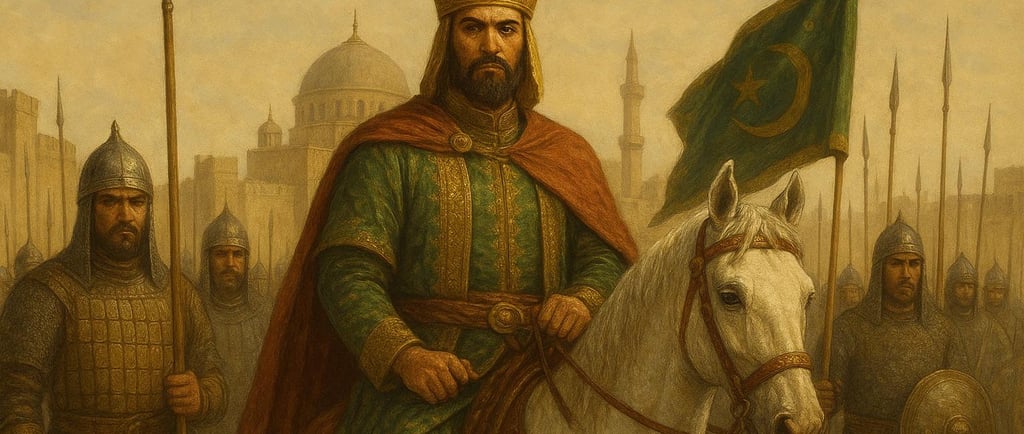The Rise and Fall of the Mamluk Sultanate's Monetary System: Lessons for Modern Gold and Silver Investors
EDUCATION ON GOLD & SILVER


Introduction to the Mamluk Sultanate: A Brief Overview
The Mamluk Sultanate, established in the 13th century, represents a significant and unique paradigm in the history of governance. Originating from a group of slave soldiers who were predominantly of Turkish and Circassian descent, the Mamluks rose to prominence following the defeat of the Mongol invasions. They seized control of Egypt and the Levant, effectively dethroning the Ayyubid dynasty and establishing a regime that would endure for approximately three centuries until the 16th century.
During this period, the Mamluks not only solidified their military prowess but also became integral players in the broader political dynamics of the region. Their rule marked a transformative era characterized by a complex socio-economic structure. The Mamluks demonstrated remarkable adaptability, transitioning from subservient warriors to autonomous leaders. This transition was facilitated by several key historical milestones, including victory at the Battle of Ain Jalut in 1260, which halted the Mongol expansion into the Middle East.
Cairo, the capital of the Mamluk Sultanate, emerged as a vibrant center of trade and culture, attracting scholars, merchants, and artisans. The sultanate's influence extended beyond military conquests, as it became a hub for commerce, particularly in luxury goods and agricultural products. The Mamluks capitalized on their geographical location by controlling critical trade routes, leading to prosperous economic conditions that allowed them to finance their intricate governance systems.
The unique structure of the Mamluk state and its diverse influences set the stage for the development of a distinct monetary system. This system was responsive to the shifting political, social, and economic conditions of the time. Understanding the Mamluk Sultanate's evolution provides valuable lessons for contemporary investors in gold and silver, illustrating how historical monetary practices shaped wealth management strategies. The rise and fall of this empire underline the importance of flexibility and adaptability in economic systems.
The Mamluk Monetary System: Structure and Evolution
The monetary system of the Mamluk Sultanate, which flourished from the 13th to the 16th centuries, served as a sophisticated framework for trade and economic activity across the regions of the Middle East. At the heart of this system were two primary coins: the gold dinar and the silver dirham. The dinar, a weight-based currency, derived its value from a consistent gold standard, while the dirham was similarly regulated by a silver standard. These monetary units not only facilitated domestic trade but also played a pivotal role in international commerce, especially with the burgeoning trade routes connecting Europe and Asia.
Significant reforms within the Mamluk monetary system were introduced by prominent rulers such as Sultan Qalawun and Sultan Al-Nasir Muhammad. Sultan Qalawun, reigning in the 13th century, implemented measures to stabilize and legitimize the currency, cycling through various issuances of standard coins. His policies aimed at curbing inflation and enhancing trust among traders. This maintenance of currency intrinsic value was essential for sustaining long-distance trade networks, ensuring that both local and foreign merchants found it viable to partake in market activities.
Sultan Al-Nasir Muhammad, who led several reforms in the following century, continued this legacy. His introduction of a new, lightweight silver dirham allowed for greater circulation and ease of transaction, catering to the needs of a growing economy characterized by its mercantile spirit. The subsequent proliferation of these coins can be traced through several notable historical events, such as the Battle of Ain Jalut in 1260, which marked a significant shift in power dynamics and indirectly influenced fiscal policies.
This evolution of the Mamluk monetary system encapsulates a timeline of adaptive reforms and policies reflecting the economic landscape of the era. Through these pivotal changes in monetary policy, the Mamluk Sultanate demonstrated a keen understanding of how currency stability directly correlates with trade and economic prosperity, lessons that remain relevant for modern investors in precious metals.
The Reasons Behind the Decline of the Mamluk Monetary System
The Mamluk Sultanate, once a formidable power in the Middle East, witnessed a gradual decline in its monetary system, which reflected larger issues within the state. Among the primary factors contributing to this decline were internal strife and power struggles. These conflicts weakened the central authority and led to fragmentation within the kingdom. As various factions vied for control, the coherence of monetary policy suffered significantly, resulting in a lack of confidence in the currency.
In addition to internal challenges, the rise of the Ottoman Empire posed a significant external threat. The Ottomans, known for their advanced military strategies and economic policies, steadily encroached upon Mamluk territories. Their expansion not only diminished Mamluk influence but also disrupted trade routes and economic stability. This shift in power dynamics had a detrimental impact on the Mamluk monetary system, as the Sultanate struggled to compete with the more economically robust Ottomans. The increasing reliance on mercenaries and foreign expeditions further drained resources, exacerbating the economic mismanagement that had already begun to take root.
Economic mismanagement, primarily characterized by inflation and debasement of currency, played an equally critical role in the monetary decline. The Mamluks resorted to minting lower-quality coins to meet fiscal demands, causing rampant inflation. This debasement eroded public trust in the currency, leading to decreased circulation and commerce. The disarray in financial governance also hindered trade relations with neighboring regions, ultimately driving merchants and investors to seek more stable environments. Notably, these missteps serve as important lessons for modern investors in precious metals, emphasizing the need for prudent monetary management and the dangers of over-reliance on external stability.
Takeaways for Modern Investors: The Relevance of Precious Metals
The history of the Mamluk Sultanate offers critical insights for contemporary investors, particularly concerning the investment in precious metals such as gold and silver. Throughout history, gold and silver have served not only as currency but also as reliable stores of value. The Mamluks, who recognized the importance of maintaining a stable and trusted monetary system, relied heavily on these metals for trade and economic prosperity. Their practices underscore the enduring relevance of precious metals, especially in times of economic uncertainty.
In today's volatile financial landscape, precious metals continue to demonstrate their value as a hedge against inflation and currency devaluation. Investors must consider that fluctuations in fiat currency can diminish purchasing power over time, making the inclusion of gold and silver in an investment portfolio increasingly appealing. The steadfast nature of these metals allows them to retain their worth, often outperforming other asset classes during economic downturns.
Modern investors can draw several practical lessons from the Mamluk experience. Firstly, diversifying one's asset allocation to include precious metals is prudent. This strategy can help mitigate risks associated with overexposure to stocks or bonds. Gold and silver not only provide a buffer during financial crises but also have historically appreciated in value over the long term.
Secondly, understanding market trends and historical price movements of these metals can empower investors to make informed decisions. Monitoring global economic indicators, geopolitical events, and current demand can provide a better context for timing purchases. This historical perspective of the Mamluks enhances our comprehension of how precious metals react to market changes.
In conclusion, the Mamluk Sultanate's monetary history serves as a compelling reminder of the importance of precious metals in investing. Their reliability and historical significance highlight the need for modern investors to integrate gold and silver into their financial strategies, thus ensuring stability and value preservation in an ever-evolving economic landscape.
